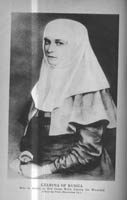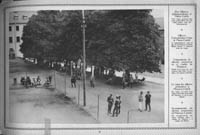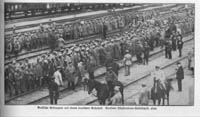Table of Contents
Media Index
CHAPTER 5
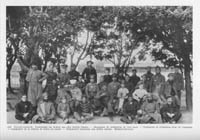
POW's from seven countries pose in this photograph taken in the prison compound at Friedrichsfeld. These troops came from Belgium, Britain, France, French West Africa, India, Russia, and Serbia and demonstrated to the German people the global challenge they faced in the war. Such photographs aided the German propaganda campaign; the Germans argued that the Allies had to rely on man power from their subject colonies to support their war effort.
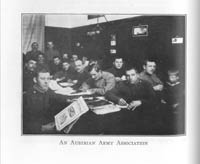
A number of Austro-Hungarian troops relax and read newspapers and magazines in the reading room of an unidentified Soldatenheim. The soldier on the left holds a copy of the Kriegsruf, a wartime newspaper, while a child in a sailor's uniform can be seen in the extreme right of the photo. Soldiers could visit the YMCA and relax in friendly surroundings.
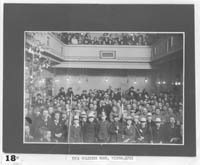
Soldiers and civilians enjoy Christmas celebrations in the Vienna Soldatenheim early in World War I. A children's "guard of honor" with flags and rifles stands in the middle of the photograph and an orchestra sits on the right. The Austrian YMCA sought to provide diversions for young men serving in the army.
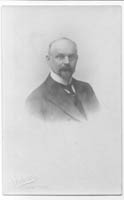
Portrait of Christian Phildius (d. 1937), the World's Alliance of YMCA's General Secretary from 1896 to 1922; he conducted negotiations to establish WPA programs in Austria-Hungary, Bulgaria, and Turkey during the war.
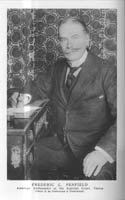
Portrait of Frederic Courtland Penfield (1855-1922), United States ambassador to Austria-Hungary from 1913 to 1917, writing at his desk.

Under the watchful gaze of Austrian guards, Serbian prisoners line up and await orders to march to an Austrian prison camp. The Serbians just arrived at the station and German soldiers, in the background, observe the Serbs. Note the empty horse drawn wagons which are lined up to be loaded with supplies from the train.
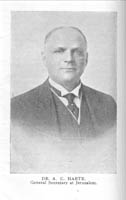
Post-war photograph of Archibald C. Harte (1865-1946) after he became the General Secretary in charge of establishing an Association in Jerusalem.
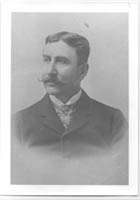
Portrait of a young James Stokes (1841-1918), an American philanthropist and strong supporter of the American YMCA; he financed the purchase of buildings and staffs for Associations in Paris, Rome, and St. Petersburg.
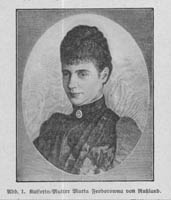
Drawing of the Empress Dowager Marie Feodorovna of Russia (1847-1928). The tsarina supported a number of charitable organizations during the war, including relief for Russian prisoners of war held in Central Power POW camps.
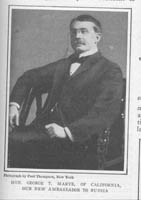
George Thomas Marye (1849-1933) was the United States ambassador to Russia from 1914 to 1916 and supported Archibald Harte's efforts to establish WPA operations in the Tsarist Empire.
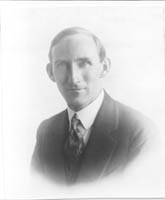
George M. Day went to Russia to serve as a Miyak Secretary in 1909 and accompanied Archibald C. Harte on an inspection tour of Russian prison camps in Siberia.
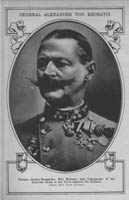
Official photograph of General Alexander von Krobatin (1849-1933), Dual Monarchy Minister of War from 1912 to 1917; he won a major victory over the Italians at the Battle of Caporetto in October 1917.
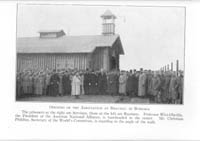
Austrian officials and officers join Russian (to the left) and Serbian (to the right) prisoners for the opening of the James Stokes Hut at Braunau-in-Boehmen, the first Association building for POW's in the Dual Monarchy. Professor Witz-Oberlin, the Secretary-General of the Austrian YMCA, stands in the center of the photograph (he is the bare-headed civilian), while Christian Phildius, a Secretary-General of the World's Committee in Geneva, stands at the angle of the walk (he is in civilian clothing and top hat). Note that the Russian and Serbian prisoners wear identification badges on their caps.
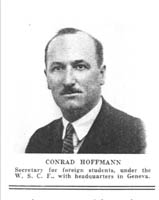
Post-war photography of Conrad Hoffman (d. 1958), the Senior American YMCA WPA Secretary in Germany during World War I.
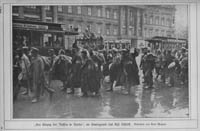
Russian prisoners of war march past the royal palace through the streets of Berlin, probably in the process of changing trains for their prison camp assignments. Civilians on the street cars watch the Russian parade. The German caption for the photograph, "Russian Entry into Berlin," was intended to point the irony that a Russian invasion consisted of millions of Russians captured by the Germans on the Eastern Front.
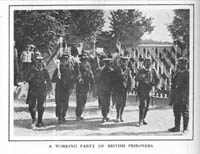
An Arbeitskommando of British prisoners of war march through the main gate of a German prison camp with shovels over their shoulders in parade fashion. Some children watch the parade to the left.
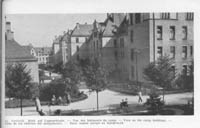
Exterior view of the four-story buildings in the prison camp at Crefeld. French and Arab prisoners can be seen sitting and strolling on the street.
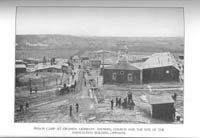
View of the prison camp at Crossen-an-der-Oder from the central watch tower, showing the church and the site of the future YMCA building the American Association planned to construct. The photograph shows several of the camp's barracks and buildings under construction.
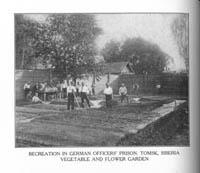
Austro-Hungarian officers stand outside of their barracks at the prison camp at Tomsk in Siberia for this photograph. Archibald C. Harte, an American YMCA secretary, met these men in 1915 during his first visit to Russia on a mission to establish War Prisoners' Aid work in the Tsarist Empire as a condition for expanding WPA services in Germany.
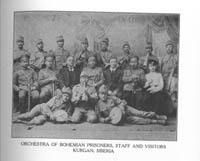
An orchestra composed of Bohemian prisoners of war with their instruments pose with Russian officers, sitting on the left and right and in the middle (the latter, presumably, the camp commandant). Two civilians also pose for the photograph; Archibald C. Harte sits on the left of the commandant and George Day is on the right. This photo was taken in 1915 when the two American YMCA secretaries traveled across Russia and Siberia to introduce War Prisoners' Aid operations in the Tsarist Empire.
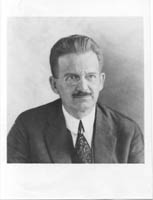
Photograph of an older Carlisle V. Hibbard (1876-1954); he negotiated with the Western Allies to begin WPA operations in 1915. Hibbard became the Associate General Secretary of the National War Work Council in New York during the Great War.
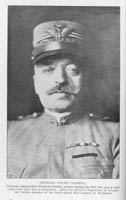
General Luigi Cardorna (1850-1928) was the Italian supreme commander from the kingdom's entry into World War I until November 1917.
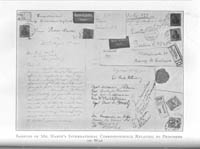
These are samples of some of the correspondence Archibald Harte received from the relatives and friends of German and Hungarian prisoners seeking information about their loved ones in captivity. Many families lost contact with their fathers and sons on the Eastern Front and Harte's trips to Russia sparked some hope that these families could find out some information.
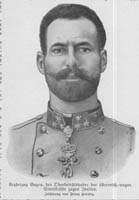
Pen and ink portrait of Archduke Eugene of Austria (1863-1954) Austrian commander on the Balkan and Italian Fronts during World War I.
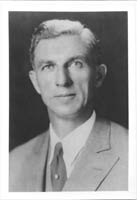
Photograph of an older Darius A. Davis (1883-1970), an American YMCA WPA Secretary in France and Italy early in the war, he became the Senior American YMCA Secretary in France when the U.S. joined the Allies in 1917.
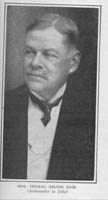
Thomas Nelson Page (1853-1922) served as the United States ambassador to Italy from 1913 to 1919; he supported the organization of American YMCA WPA operations in Italy during the war.
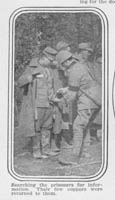
An Italian soldier searches recently captured Austro-Hungarian troops for weapons and military information. These prisoners will be sent to a collection point and transported to Italian prison camps for the duration of the war.
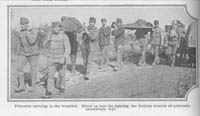
Austro-Hungarian prisoners of war carry litters with wounded men to the rear area under Italian guard in this photograph. These men will soon be sent to prison camps across Italy to spend the rest of the war behind barbed-wire.
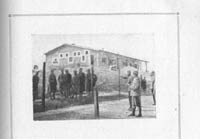
A group of Russian and Romanian prisoners stand next to the compound fence in conversation with Italian POW's in the prison camp at Mauthausen. A barrack stands on the hill behind the Russian and Romanian prisoners.
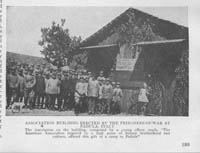
Italian troops and an American YMCA secretary, in civilian clothing, stand outside the newly inaugurated YMCA building at the POW camp in Padula, Italy. The American YMCA provided the funding for the building and Central Power prisoners of war provided the labor in the hut's construction.
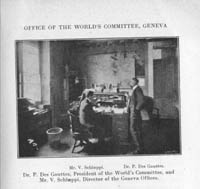
Paul Des Gouttes was the President of the World's Committee of the World's Alliance of YMCA's in Geneva and the Honorary General Secretary of the International Red Cross during World War I. Dr. Des Gouttes stands at the right, talking to Victor Schlaeppi, seated, in the Geneva office.
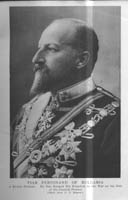
Wartime portrait of Tsar Ferdinand of Bulgaria (1861-1948); he led his kingdom through three Balkan wars and abdicated his throne in September 1918 as a result of the Allied break-out at Saloniki.
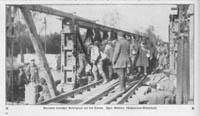
Serbian prisoners of war cross a railroad bridge over the Danube, leaving Serbia and entering Austria-Hungary, under Austrian guard. German soldiers at the lower right and on the bank of the river to the left watch the Serbians pass into Austrian captivity.
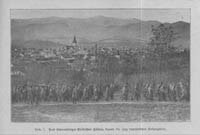
Captured Romanian troops march past the Transylvanian city of Heltau and into captivity in September 1916.
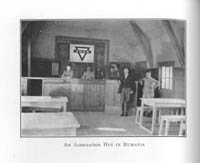
Interior of a YMCA hut set up for Romanian soldiers in Wallachia in 1917 by American YMCA secretaries. The civilian standing to the right is one of the American Red Triangle workers who volunteered for service in the kingdom after the United States entered the war and the Association expanded war work service to Allied soldiers across Europe.
